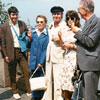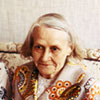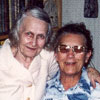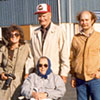Ellen Erdman
Ellen's story in her own words, August 1988
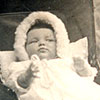 My first remembrance is of Grandma (Mari) knitting grey socks for the First World War soldiers. She received an award from the government for knitting 100 pairs. When I was older, I learned that we lived with our Grandparents in their 5-room house until 1914, when we moved to our own farm. There we lived in a small 2-room house with a wood/coal burning stove, coal lamp, a sewing machine and wash tubs with scrub boards.
My first remembrance is of Grandma (Mari) knitting grey socks for the First World War soldiers. She received an award from the government for knitting 100 pairs. When I was older, I learned that we lived with our Grandparents in their 5-room house until 1914, when we moved to our own farm. There we lived in a small 2-room house with a wood/coal burning stove, coal lamp, a sewing machine and wash tubs with scrub boards.
We heated the wash water in a big boiler on the stove and rinsed the clothes in cold water, with bluing for white things. I remember helping to make soap in the yard during the summer. We saved all the grease from cooking and from butchering and put it in a great, heavy kettle. It was set on rocks and a fire was built under it. After it had cooked for some time, lye was added, then it was poured into pans. After it cooled, we cut the soap into pieces and discarded the junk at the bottom. We used this soap only for washing clothes, and bought soap for us to wash with - Crown, Ivory, Life Boy. My mother used flat irons for ironing, which were heated on the stove top.
Our outdoor toilet was beside the wood pile and we were required to bring in wood whenever we went out there. For toilet paper, we used the Eaton's catalogue pages and orange papers.
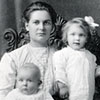 In 1914, the hay stack burnt down. I have memories of Victor and me with a box of matches, striking them by the hay stack. I guess it caught on fire. We ran and hid under Mother and Dad's bed. (And I blamed Ralph, 1 year old!) Neighbours came to help put it out, using wet gunny sacks, pitch forks, and water buckets. I don't remember our punishment, but the matches were put out of our reach thereafter. We couldn't reach them even when we stood on a wooden Japanese orange box on top of a chair!
In 1914, the hay stack burnt down. I have memories of Victor and me with a box of matches, striking them by the hay stack. I guess it caught on fire. We ran and hid under Mother and Dad's bed. (And I blamed Ralph, 1 year old!) Neighbours came to help put it out, using wet gunny sacks, pitch forks, and water buckets. I don't remember our punishment, but the matches were put out of our reach thereafter. We couldn't reach them even when we stood on a wooden Japanese orange box on top of a chair!
Mother was concerned when the Indians came down the road, on the way to or from the Lethbridge Stampede, and she would make us hide under the bed. In the summer, we kids would go barefoot, and got really tough soles. When we were older, we chased the milk cows home from the pasture and had to watch where we stepped. There were cactuses, bird nests, the usual pasture encumbrances, and even dead gophers with burying beetles at work.
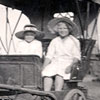 Dad had horses, cattle, sheep, pigs, ducks, turkeys, chickens and geese. Feathers were saved for pillows, sheep fleeces were washed, cleaned and carded. Mother used some of the wool to make quilts and some she spun into yarn. She could knit and read at the same time.
Dad had horses, cattle, sheep, pigs, ducks, turkeys, chickens and geese. Feathers were saved for pillows, sheep fleeces were washed, cleaned and carded. Mother used some of the wool to make quilts and some she spun into yarn. She could knit and read at the same time.
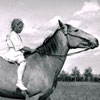 Dad raised Belgian work horses, but he also kept an extra horse for us children to ride. For some people this was a treat. However, I didn't enjoy horse back riding very much. One time when I was riding, the horse went under the fence instead of over it. I got a big gash on my left arm. After that, I was even less interested in riding.
Dad raised Belgian work horses, but he also kept an extra horse for us children to ride. For some people this was a treat. However, I didn't enjoy horse back riding very much. One time when I was riding, the horse went under the fence instead of over it. I got a big gash on my left arm. After that, I was even less interested in riding.
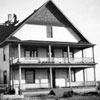 In 1918, as the family grew bigger with 6 of us now - Victor, me, Ralph, Oscar, Alfred and Mary - Dad built a large 2-story house, with many modern conveniences; Delco power plant for light, hot and cold running water with an electric pump, in-door bathroom, a steam furnace to heat all the rooms, and a dumb-waiter. The dumb-waiter was moved by pulleys and carried food from the kitchen to the basement to keep it cool.
In 1918, as the family grew bigger with 6 of us now - Victor, me, Ralph, Oscar, Alfred and Mary - Dad built a large 2-story house, with many modern conveniences; Delco power plant for light, hot and cold running water with an electric pump, in-door bathroom, a steam furnace to heat all the rooms, and a dumb-waiter. The dumb-waiter was moved by pulleys and carried food from the kitchen to the basement to keep it cool.
There was a fire place in the living room and a pool room upstairs - the pool table hauled up over the veranda into the pool room. Dad got it to keep the boys at home, so they wouldn't have to go to town. However, mostly the men played pool and my brothers didn't have a chance.
I remember the lumber for the house being hauled in with wagons. The man who installed the lath for the plaster was a marvel. He put the shingle nails in the mouth, for quick access, and was very fast in nailing up boards. We were amazed!
The furniture was ordered from Eaton's Catalogue. The arrival of the Eaton's Catalogue was an exciting event and we ordered many items from it. The pages with the toys were pretty worn out by Christmas. I remember Dad ordering a sewing machine for Mother while were still at the little house. It was a Raymond and it cost $25! Mother sewed all our clothes, even the boys' pants. Dad also bought a gramophone with some records. We kids enjoyed it very much and played it very often.
The food we ate was mostly home-grown; vegetables, chicken, duck, goose, pork lamb, turkey, beef, and even rabbit. Dad would order small barrels of herring and frozen fish in the winter. During hard times, Dad took our wheat to Claresholm to be ground into flour. From the milk, we made butter and cottage cheese. Of course, we always had delicious home-made bread. Mother usually made 8 to 10 loaves at a time. We had lots of boxes of apples in the basement in the fall - sometimes oranges. We made big crocks (10 or 20 gallons) of sauerkraut, corned beef and salt pork. Mother always canned a lot of fruit and made lots of pickles.
A salesman would come in the fall, and Dad would order raisins, dried apples, prunes, icing sugar, coconut, etc. We would eat so much of one thing and not want any more for months. Dad bought peanuts for us when he went to town, but never candy. One of our hired men bought peppermints, the kind with the very hot middle, and gave them to us. I did not like peppermint for many years after that. Sometimes on a Sunday drive, checking the crops, Dad would buy us ice cream cones. That was a treat!
We usually had porridge for breakfast; rolled oats, cream of wheat, rolled wheat or ground wheat with brown sugar and milk. Occasionally we had eggs, pancakes or French toast with jam. We drank milk, once in a while cocoa, but not tea or coffee. I didn't learn to drink coffee till I was about 17, when I belonged to a girls' club. At harvest time, we also had pies, puddings, and cakes when we had several hired men, but very seldom at other times.
The water in our well was fine for the farm animals, but it was not good to drink, so we hauled water from our neighbour, Korby. We put it in the cistern beneath the cellar. When the water wagon was dry, we kids would hide in it. I don't know of Mother and Dad ever knew. We also had a rain barrel for washing hair and watering the plants.
Dad hunted rabbits and coyotes for their pelts, which were sold to fur buyers who came around occasionally.
In the fall of 1918, Victor (7 years old), Ralph (5), and I (6) started school together, none of us speaking English as we always spoke Estonian at home. There were many children of other nationalities who could not speak English either. Learning English was a little difficult for me, since I already could read Estonian, and some of the letters had different sounds. (I am glad I learned to read, write and speak Estonian, as it made our trip to Estonia in 1978 much more interesting, and conversing with our relatives over there was much easier.)
Grade 1 was divided into A, B, and C. We were in C, but not for long, as we learned English very quickly. I enjoyed writing, spelling, and arithmetic. In the lower grades, Ralph, Cornelia DeValois and I would take turns being first, second and third in class. We used syrup or jam pails for carrying our lunch to school. The girls played hop-scotch; the boys, marbles and pom-pom-pull-away. Later on softball (baseball for the boys) and basketball were our favourite sports.
I made all my own clothes since I was 12 years old. That year, I won first prize for sewing at the school fair, surpassing a 16 year old competitor.
There was a Christmas Concert every year and it was a busy and exciting time for all of us. As the end of the school year, we had a picnic at the Oldman River bottom. The food was supplied by the parents, and we had ice cream! We played ball, and ran races and explored the trees. It was a great time.
Another exciting event was when the Chautauqua came to town. It was a 'magic time'. It was held in the big hall above what is now the Firehall in Barons. There were stage shows, a fortune teller, music, a potter, magic, a hypnotist, etc. and it went on for 2 or 3 days. Dad was instrumental in helping to get the show to come to such a small place as Barons.
We had chores to do as did all farm children. We milked the cows before school and in the evenings, cleaned the barn, hoed the garden (even when we were very young), gathered the eggs, poisoned the grasshoppers. The boys looked after the pigs and later helped with the farming. Our hired men were mostly Estonian or Russian.
One time a man came looking for work, riding in a taxi. It was wet weather and the other workers were cleaning out the barn. The prospective employee went right back.
Dad took us to fairs, stampedes, and to visit other Estonians, mostly relatives. We went on picnics, sometimes just our family, and other times with others. Everyone would dress up in suits, hats, and look very nice. When Dad bought some land at the Carmangay River bottom, we would go there to pick saskatoons, chokecherries, and gooseberries. The saskatoons were good to eat just as they were, canned and they made delicious pies, the chokecherries were usually made into syrup for pancakes, and the gooseberries were made into pies and jam.
The Estonians did a lot of visiting; to Linda and Big Gus Erdman's at Easter time, when we would have special ethnic pastries and breads; to Pertel's at chokecherry picking time. We would eat so many that our mouths were dark and puckered. At all of these gatherings, the Estonians would discuss farming, families, politics, etc. and sing all the old Estonian songs.
At our place, the men would throw horse shoes, play pool and squaw wrestle. We bigger children would play anti-I-over the house. Sometimes, in the summer the Estonian Minister Silak would come to hold sermons, marry people, baptize babies, etc. He had an organ that would fold into a suitcase and that provided the music.
In the early days, for Christmas presents we were given spin-the-button, checkers, dominoes, snakes and ladders. Mother would knit mitts and socks, make fancy handkerchiefs and rag dolls from the pattern on the back of the flour sacks for us girls. An uncle always gave us books.
One Christmas, I got an Eaton's 'Beauty' doll from my Godfather - what a beautiful present! It was kept in the bottom drawer of a chiffonier and I could only have it at special times. It got lost, and much later I found it under the caragana hedge, dirty, with its face peeling. It was a sad time for me.
In the winter of 1918 (the time of the flu epidemic) I had double pneumonia; my fever was so high I had blisters on my eyes, mouth and ears. My parents were very worried: the doctor had given me up. They had Grandma come. She put cottage cheese on my back to bring the temperature down - they say that saved me. When I was a little better, they asked me what I wanted to eat. I said 'sardines'. Unfortunately, they did not stay down. At this time, one of my teachers sent me a red lace valentine. It was the prettiest valentine I ever received!
In 1920 or 1921, my grandparents (Jacob and Mari), Aunt Mina and her husband, Anton Kulpas, and their children moved to Oregon. They were seeking milder weather for the benefit of Mina, who had a delicate constitution. Their land in Oregon had cherry and walnut trees. Dad took us out of school (2 or 3 times) the last week of June to go down to pick cherries. We certainly did; picked them and ate them! Getting out of school early made us the envy of our friends.
When Mina died in 1929, Dad, Aunt Charlotte, Ralph, Oscar and I moved Grandmother and Grandfather back to Barons in our car. They lived at their homestead for a while, then moved in with Mother and Dad.
Grandmother learned to write at 50 (although she could read a long time before) taught by her daughter Helene Kotkas. Her writing was poor, but her spelling was correct. My Grandfather died in 1934, and Grandmother wanted to live in her own place. Victor and Hilda were married about that time and they lived with her. She died in 1939.
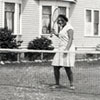 While we were in high school, Louise Kotkas and I would sometimes visit over-night. Once I went to a dance at the Finn Hall with them (my parents didn't ever let me go) and I didn't tell my Mother and Dad, but I think they knew. I also visited Lillian Laine.
While we were in high school, Louise Kotkas and I would sometimes visit over-night. Once I went to a dance at the Finn Hall with them (my parents didn't ever let me go) and I didn't tell my Mother and Dad, but I think they knew. I also visited Lillian Laine.
Ralph and I finished grade 11 in Barons in 1929. Because there was no grade 12 at that time, we went to Claresholm and took Agriculture and Home Economics. In 1931, when the new school opened and grade 12 was taught, Ralph and I took that class and graduated in 1932.
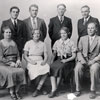 In 1933-34, I attended the University of Alberta, taking the first year of the Home Economics course. I took part in some sports - ball throws, discus, javelin - and participated in competitions in Edmonton and Saskatoon, where I won a prize or two.
In 1933-34, I attended the University of Alberta, taking the first year of the Home Economics course. I took part in some sports - ball throws, discus, javelin - and participated in competitions in Edmonton and Saskatoon, where I won a prize or two.
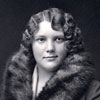 The first year I stayed in residence. The following year Ralph, Oscar, Mother and I had an apartment in a home, with Mother doing the cooking. The first year it cost Ralph and me just under $1,000 for all expenses, including room and board. ($30 a month for me and $29 for Ralph.) Ralph and I helped out at home between University terms.
The first year I stayed in residence. The following year Ralph, Oscar, Mother and I had an apartment in a home, with Mother doing the cooking. The first year it cost Ralph and me just under $1,000 for all expenses, including room and board. ($30 a month for me and $29 for Ralph.) Ralph and I helped out at home between University terms.
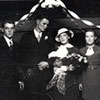 Roy Johnson, a neighbour, I were going together.We were married November 1, 1935 - a very special occasion. The day was cold, snowy and -25 degrees Fahrenheit. Dad took us to Lethbridge to get our registration and my bouquet of red roses. It was very bad weather and we were 2 hours late. The wedding was at my parents' home and I wore a navy suit that I had made, with a white hat and gloves, and I carried the roses. My sister, Mary, was my bridesmaid and my brother, Oscar, was best man. The local minister, Reverend Brett, performed the ceremony and his daughter, Mary, played the Wedding March on the piano. Mrs. Andrekson helped make the wedding cake and I decorated it. Mother and Dad gave us some furniture (my granddaughter, Jaye Gullickson Howes has the rocking chair) 2 cows, chickens and turkeys.
Roy Johnson, a neighbour, I were going together.We were married November 1, 1935 - a very special occasion. The day was cold, snowy and -25 degrees Fahrenheit. Dad took us to Lethbridge to get our registration and my bouquet of red roses. It was very bad weather and we were 2 hours late. The wedding was at my parents' home and I wore a navy suit that I had made, with a white hat and gloves, and I carried the roses. My sister, Mary, was my bridesmaid and my brother, Oscar, was best man. The local minister, Reverend Brett, performed the ceremony and his daughter, Mary, played the Wedding March on the piano. Mrs. Andrekson helped make the wedding cake and I decorated it. Mother and Dad gave us some furniture (my granddaughter, Jaye Gullickson Howes has the rocking chair) 2 cows, chickens and turkeys.
We had our first home in Roy's Mother's yard, the renter's house with 2 rooms and a porch. Roy worked for my Father, farming. We were very excited when our first child, Barbara Kay, was born in September 1936 at the Carmangay Hospital, Dr. Dimock of Barons in attendance.
Coyotes got most of our turkeys that night. When Roy took us home, he started calling Barbara 'Jo' and she has been 'Little Jo' or 'Joey' ever since.
Next year we had a chance to go to Edmonton where Roy attended Normal School (a school to teach people how to teach). We couldn't take Barbara with us, so my folks had her for that winter. I cooked for Oscar, Ralph, and Clarence Johnson, and Roy until April 1938, when I came home for the birth of our first son, Gerald. He was born April 10th at the Galt Hospital in Lethbridge, a joyous addition to our family.
That September Roy started teaching at Black Spring Valley, grades 1 - 9 inclusive. Barbara would go to school to see Daddy every so often. His salary was very low: $880 for the year, which included an extra $100 since he was married.
Our second son, Lawrence, was born August 20, 1939, at the Carmangay Hospital, joining our very lively family. That winter we stayed at my grandparents' home as Roy was unable to get another school. In the spring (1940) Roy had a chance to buy some land, section 4-13-23-W4, on time. We moved 2 buildings ¼ mile west of the railway tracks, made a room between them and that was our home. We farmed the first year with borrowed or time-purchase machinery. Roy's mother was living with us then.
We had 2 cows, some turkeys, chickens and pigs. Our Stove was coal-burning and we had a coal-oil lamp. To help supplement our income, we shipped cream and sold eggs and turkeys, and later on, pigs. One time when we returned from town, there was a pig in the house. Somehow it had got into the porch and got shut in. It climbed in and out of the bath-tub, spilled milk and broke eggs. What a mess to clean up! Another time, there were turkeys in the house.
One Saturday evening, all of us went to Barons to get the mail and groceries and to see a show but a dust storm blew in. The storm was so bad Roy couldn't see the road, so we stayed with friends until it died down. When we got home, the house was full of dust.
We always had a big garden and everyone helped.
When the children were small, I helped out in the fields at harvest time. I hired a school girl to help in the house for $1 a day for 10 days. Her mother thought I was paying her too much. For many years, I had a hired girl to help with the children, milking cows, separating milk, making butter and plucking chickens.
One of the first things Roy built on the farm was a barn, and ever since, he has built something nearly every year; granaries, shop, chicken house, pig pen, self-feeder, machinery, house, etc. He can fix, build, and re-build anything! He dug a well to we didn't have to haul water by barrel and stone-boat from his brother Lloyd's place, a mile away.
In 1943, July 11, our youngest son, Dennis, was born in Camangay. Our potatoes froze while I was in the hospital. In 1946, January 2, Marilyn was born in Lethbridge, and she completes our family. We were very fortunate to have healthy children, who were able to help us and enjoy our life together - the hard time and the good times.
In 1947, Roy dug a cellar for a new house. The spring run-off was phenomenal: there was so much rain and snow it filled 'Erdman Lake' - and the new basement.
The lake was around for several years and we made the most of our front-door recreational facility. We canoed, boated, swam and skated.
We moved the house, barn and shop (brick by brick) to higher ground, our present location, where we started a new house in 1949, of concrete and cinder brick.
I designed the house, but forgot to make any allowance for the thickness of the walls, so Roy had to adjust the plans as the house was being built. As a grand gesture, I laid the corner brick. Unfortunately, it was so crooked that it had to be re-done. We built the house with some hired help, and in 1950 we moved in.
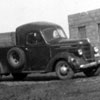 Our first car was a model T, 2 door coupe. While Roy was teaching, we had an old Plymouth. When we started farming, we got in International Panel Van that Roy converted into a tuck, with a space behind the driver's seat for the children to stand: the first extended-cab pickup.
Our first car was a model T, 2 door coupe. While Roy was teaching, we had an old Plymouth. When we started farming, we got in International Panel Van that Roy converted into a tuck, with a space behind the driver's seat for the children to stand: the first extended-cab pickup.
Most of our machinery was older and always needed repairing. When we got our first NEW self-propelled combine, it was really a treat!
I attended art classes in Banff, the first in 1962, and then again twice in later years. From this institution, I received a 'Senior Certificate in Painting'. Painting is one of my favourite pastimes and I have taken courses in Lethbridge and district.
In addition, I enjoy knitting, crocheting, quilt making, pottery, baking, stone polishing, and won several awards and prizes at all of these activities. I also enjoy bird watching and photography. I have belonged to Art Clubs and taken and taught art classes.
I take particular delight in keeping touch with our many relatives, including 11 grandchildren and 6 great grandchildren.
Roy enjoys fishing, hunting, and throwing horse shoes. As an active member of the community, Roy was on the Barons School Board for many years and a member of the Carmangay Hospital Board. His hobby is simplifying his farm machinery - 'Johnsonizing'- and inventing other useful farm equipment. His grandchildren have been getting him to teach them how to do puzzles, among them Rubic's Cube and Rubic's Revenge.
Roy and I started traveling in the winter, mainly to visit relatives in Vancouver, Victoria, Oregon, and California. In 1955, Dad, Charlotte and I went to Hawaii; Roy and I went to Montreal Expo '67, visiting Leroy and Barbara in Toronto at the same time; and various trips to Hawaii, Gerry and family were there; and one to Mexico.
In 1978, Glenda (Erdman) Cunningham and I arranged a trip with stops at Stockholm, Sweden; Helsinki, Finland; Tallinn, Estonia; Leningrad, Kiev and Yalta in the USSR; and Warsaw, Poland. Our group was made up of Hilda (Saffel) Wollen, Walter Saffel, Albert Munz, Lawrence Kotkas, Barbara (Johnson) Gullickson, Glenda (Erdman), John Cunningham, and myself.
We are related to our people in Estonia through my Mother, Madga (Lik) Erdman. We thoroughly enjoyed visiting with them and seeing the sights. They were pleased I could speak Estonian. This trip will be something I will always remember.
The next overseas trip was in 1984, when Barbara, Roy and I went to Scandinavia, visiting Helsinki, Finland, where Roy's mother was born, and Hammerfest, Norway, the birthplace of his father. Barbara's oldest son, Derek, and his wife were living in Stavanger, and they traveled with us part of the way. It was all over too soon.
Roy and I have lived in the Barons area since 1940, acquiring 2 ½ sections of land. At the present time, 2 sections are rented out, but we still farm ½ section, enough so that we still worry about the weather.
 On November 1, 1985, Roy and I celebrated our 50th Wedding Anniversary. Barbara arranged an intimate afternoon and evening with relatives and closest friends. Approximately 250 people arrived with good wishes. Among them were Roy's and my surviving brothers, our 5 children, all but one of our 11 grandchildren and all but the youngest of our great grandchildren (20 days old).
On November 1, 1985, Roy and I celebrated our 50th Wedding Anniversary. Barbara arranged an intimate afternoon and evening with relatives and closest friends. Approximately 250 people arrived with good wishes. Among them were Roy's and my surviving brothers, our 5 children, all but one of our 11 grandchildren and all but the youngest of our great grandchildren (20 days old).
Our daughter, Marilyn, was married the same day to Don Eamer in Vancouver, and they flew out here in time for our party.
All of our children went to the Barons Consolidated School, finishing grade 12, taking part in sports and music. I spent many hours at our pool (which Roy built in 1952) watching the children and their friends frolic in the water. One of their favourite school party treats was chocolate angel food cake which I still make for family occasions.
Each one of our children have worked for and received university degrees, ranging, from Bachelors to Doctorates.
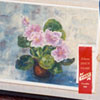 We have had a wonderful life together. Our family get-togethers for birthdays, and other occasions keep us from getting old too fast. We are very fortunate to have 2 children living near us. Barbara and Denny are considerate and thoughtful. We are very proud of all our children, our grandchildren and our great grandchildren. All of them give us great pride, fulfillment and happiness.
We have had a wonderful life together. Our family get-togethers for birthdays, and other occasions keep us from getting old too fast. We are very fortunate to have 2 children living near us. Barbara and Denny are considerate and thoughtful. We are very proud of all our children, our grandchildren and our great grandchildren. All of them give us great pride, fulfillment and happiness.
Ellen Catherine Erdman
Born at Barons, July 17, 1912
Mari Erdman (Grandmother) and
Helene (Erdman) Kotkas midwives
Died March 4, 1989 at Lethbridge
Ashes spread on the Barons Cemetery
Roy Johnson
Born at Barons, March 22, 1912
He added the initial 'R' to his name because
There was another 'Roy Johnson' in the area.
Died August 6, 2002
Ashes spread on the Barons Cemetery

